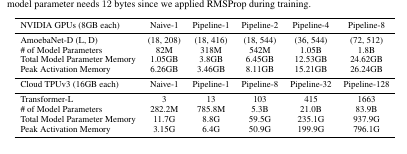Introduction to GPipe
The paper titled 'GPipe: Easy Scaling with Micro-Batch Pipeline Parallelism' introduces a novel method for efficiently training large neural networks. The increasing complexity of deep learning models has made optimizing their performance critical, especially as they often exceed the memory limits of single accelerators. GPipe addresses these challenges by enabling effective model parallelism and improving resource utilization without sacrificing performance.
Pipeline Parallelism Explained

Scaling deep learning models typically requires distributing the workload across multiple hardware accelerators. GPipe specifically focuses on pipeline parallelism, where a neural network is constructed as a sequence of layers, allowing for parts of the model to be processed simultaneously on different accelerators. This approach helps in handling larger models by breaking them into smaller sub-parts, thus allowing each accelerator to work on a segment of the model, increasing throughput significantly.
The authors argue that by utilizing 'micro-batch pipeline parallelism,' GPipe enhances efficiency by splitting each mini-batch into smaller segments called micro-batches. Each accelerator receives one micro-batch and processes it independently, which helps facilitate better hardware utilization compared to traditional methods that may lead to idle processing times on some accelerators due to sequential dependencies between layers[1].
Advantages of Using GPipe
Improved Training Efficiency
![None title: 'Figure 1: (a) Strong correlation between top-1 accuracy on ImageNet 2012 validation dataset [5] and model size for representative state-of-the-art image classification models in recent years [6, 7, 8, 9, 10, 11, 12]. There has been a 36× increase in the model capacity. Red dot depicts 84.4% top-1 accuracy for the 550M parameter AmoebaNet model. (b) Average improvement in translation quality (BLEU) compared against bilingual baselines on our massively multilingual in-house corpus, with increasing model size. Each point, T(L, H, A), depicts the performance of a Transformer with L encoder and L decoder layers, a feed-forward hidden dimension of H and A attention heads. Red dot depicts the performance of a 128-layer 6B parameter Transformer.'](https://askpandipro.s3.amazonaws.com/users/48/documents/167/figures/1.png?AWSAccessKeyId=AKIAQT4QH3CHNPX5WHX7&Signature=MupBCXfdpNRS0xeJLDTHS7MTbLE%3D&Expires=1764886861)
GPipe not only maximizes the capacity of large-scale models but also provides substantial improvements in training speed. The paper reports that using GPipe with various architectures yields significant speedups when scaling the number of accelerators. For example, when training an AmoebaNet model, the authors noted that scaling to 8 accelerators enhanced the training efficiency multiple times compared to non-pipelined approaches[1].
Flexibility in Model Structures
One of the standout features of GPipe is its adaptability to various model architectures, such as convolutional neural networks and transformers. GPipe supports different layer configurations and can dynamically adjust to the specific needs of a given architecture. This flexibility provides researchers and practitioners with the tools they need to optimize models for diverse tasks, including image classification and multilingual machine translation, as demonstrated through their experiments on large datasets[1].
Experiments and Findings

Through extensive experiments, the authors demonstrate that GPipe can effectively scale large neural networks. They utilized various architectures—including the 557-million-parameter AmoebaNet and a 1.3B-parameter multilingual transformer model—across different datasets like ImageNet and various translation tasks.
The results showed that models trained with GPipe achieved higher accuracy and better performance metrics, such as BLEU scores in translation tasks, compared to traditional single-device training methods. Specifically, they achieved a top-1 accuracy of 84.4% on ImageNet, showcasing the potential of deeper architectures paired with pipeline parallelism[1].
Addressing Performance Bottlenecks
The design of GPipe counters several potential performance bottlenecks inherent in other parallel processing strategies. One major challenge is the communication overhead between accelerators, particularly in synchronizing the gradient updates. GPipe introduces a novel back-splitting technique that minimizes this overhead by allowing gradients to be computed in parallel while ensuring they are updated synchronously at the end of each training iteration. This allows for seamless integration across multiple devices, significantly reducing latency and maximizing throughput[1].
Practical Implementation Considerations
Implementing GPipe requires considerations around factors like memory consumption. The paper discusses how re-materialization, during which activations are recomputed instead of stored, can significantly reduce memory overhead during training. This is particularly beneficial when handling large models that otherwise might not fit into the available capacity of a single accelerator. By applying this strategy, GPipe can manage larger architectures and ensure efficient resource allocation across the various components involved in training[1].
Conclusion

GPipe represents a significant advancement in the training of large-scale neural networks by introducing pipeline parallelism combined with micro-batching. This innovative framework allows for efficient model scaling while maintaining training performance across different architectures. The approach not only enhances scalability but also provides a flexible and robust solution for tackling modern deep learning challenges efficiently. Researchers and engineers can leverage GPipe to optimize their training regimes, making it a valuable tool in the ever-evolving landscape of artificial intelligence[1].
Get more accurate answers with Super Pandi, upload files, personalized discovery feed, save searches and contribute to the PandiPedia.
Let's look at alternatives:
- Modify the query.
- Start a new thread.
- Remove sources (if manually added).